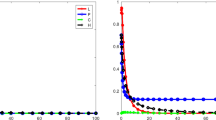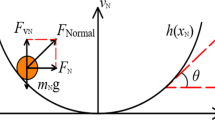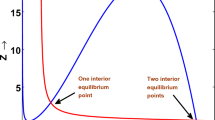Abstract
In this paper, we have considered a discrete-time modified Leslie-Gower type predator-prey model with mate-finding Allee, Holling Type-I functional response and predator harvesting. We have discussed the conditions of existence of the feasible equilibrium point. The stability criterion of the equilibrium point is carried out algebraically. Analytically we have shown that the system undergoes through transcritical bifurcation with respect to the rate of harvesting, period doubling bifurcation and Neimark-Sacker bifurcation considering the discretization factor (generation gap) as a bifurcation parameter. All the bifurcation phenomena have been justified numerically. Numerically we also studied the existence of 1:2, 1:3 and 1:4 response bifurcations and found the corresponding phase portrait in all the cases. Lastly, we have studied the policy of optimal harvesting maintaining the conservation of both the populations. The paper is ended with some conclusion.









Similar content being viewed by others
References
P. Turchin, Complex population dynamics: a theoretical/empirical synthesis (MPB-35) (2013)
A. Lotka, Elements of Physical Biology (Baltimore: Williams and Wilkins, 1925), p. 460
V. Volterra, Fluctuations in the abundance of a species considered mathematically. Nature 118(2972), 558–560 (1926)
P. Leslie, J. Gower, The properties of a stochastic model for the predator-prey type of interaction between two species. Biometrika 47(3/4), 219–234 (1960)
P. Aguirre, A general class of predation models with multiplicative Allee effect. Nonlinear Dyn. 78(1), 629–648 (2014)
R.M. May, in Stability and Complexity in Model Ecosystems (Princeton University Press, 2019)
P. Chakraborty, S. Sarkar, U. Ghosh, Stability and bifurcation analysis of a discrete prey-predator model with sigmoid functional response and Allee effect. Rendiconti del Circolo Matematico di Palermo Series 2, 1–21 (2020a)
E. González-Olivares, B. González-Yañez, J. Mena-Lorca, J.D. Flores, Uniqueness of limit cycles and multiple attractors in a Gause-type predator-prey model with nonmonotonic functional response and Allee effect on prey. Math. Biosci. Eng. 10, 345–367 (2013)
P. Feng, Dynamics and pattern formation in a modified Leslie–Gower model with Allee effect and Bazykin functional response. Int. J. Biomath. 10(05), 1750073 (2017)
P. Aguirre, E. González-Olivares, S. Torres, Stochastic predator-prey model with Allee effect on prey. Nonlinear Anal. Real World Appl. 14(1), 768–779 (2013)
Y. Lv, L. Chen, F. Chen, Stability and bifurcation in a single species logistic model with additive Allee effect and feedback control. Adv. Difference Equ. 2020(1), 1–15 (2020)
L. Yang, A new global stable conclusion on a diffusive Leslie-Gower predator-prey system with additive Allee effect. Discret. Dyn. Nat. Soc. 2019 (2019)
Y. Chow, S.R.J. Jang, Multiple attractors in a Leslie-Gower competition system with Allee effects. J. Differ. Equations Appl. 20(2), 169–187 (2014)
C.S. Holling, The components of predation as revealed by a study of small-mammal predation of the European pine sawfly. Can. Entomol. 91(5), 293–320 (1959)
C.S. Holling, Some characteristics of simple types of predation and parasitism. Can. Entomol. 91(7), 385–398 (1959)
C.S. Holling, The functional response of predators to prey density and its role in mimicry and population regulation. The Memoirs of the Entomological Society of Canada 97(S45), 5–60 (1965)
R.J. Taylor, Predation (Springer Science & Business Media, 2013)
P. Chakraborty, U. Ghosh, S. Sarkar, Stability and bifurcation analysis of a discrete prey-predator model with square-root functional response and optimal harvesting. J. Biol. Syst. 1–20 (2020b)
S. Elaydi. Discrete Chaos: With Applications in Science and Engineering (CHAPMAN &HALL/CRC, 2008)
Y.A. Kuznetsov, R.J. Sacker, Neimark-sacker bifurcation. Scholarpedia 3(5), 1845 (2008)
Y.A. Kuznetsov, Elements of applied bifurcation theory, vol. 112 (Springer Science & Business Media, 2013)
G. Chen, Y. Huang, Chaotic maps: dynamics, fractals, and rapid fluctuations. Synthesis Lectures on Mathematics and Statistics 4(3), 1–241 (2011)
S. Wiggins, Introduction to applied nonlinear dynamical systems and chaos, vol. 2 (Springer Science & Business Media, 2003)
C. Robinson, Dynamical systems: stability, symbolic dynamics, and chaos (CRC press, 1998)
J. Guckenheimer, P. Holmes, Nonlinear oscillations, dynamical systems, and bifurcations of vector fields, vol. 42 (Springer Science & Business Media, 2013)
H. Meijer, W. Govaerts, Y.A. Kuznetsov, R.K. Ghaziani, N. Neirynck. Matcontm, a toolbox for continuation and bifurcation of cycles of maps: command line use (2017)
R.K. Ghaziani, W. Govaerts, C. Sonck, Resonance and bifurcation in a discrete-time predator-prey system with Holling functional response. Nonlinear Anal. Real World Appl. 13(3), 1451–1465 (2012)
I.A. Kouznetsov, H.G.E. Meijer, Numerical bifurcation analysis of maps: from theory to software (Cambridge University Press, 2019)
K. Chakraborty, M. Chakraborty, T.K. Kar, Optimal control of harvest and bifurcation of a prey-predator model with stage structure. Appl. Math. Comput. 217(21), 8778–8792 (2011)
M. Bahri, Stability analysis and optimal harvesting policy of prey-predator model with stage structure for predator. Appl. Math. Sci. 8(159), 7923–7934 (2014)
P. Chakraborty, U. Ghosh, S. Sarkar, Stability and bifurcation analysis of a discrete prey-predator model with square-root functional response and optimal harvesting. J. Biol. Syst. 28(1), 91–110 (2020)
W.H. Chen, D.J. Ballance, P.J. Gawthrop, Optimal control of nonlinear systems: a predictive control approach. Automatica 39(4), 633–641 (2003)
Acknowledgements
The authors would want to thank anonymous reviewers for their valuable comments and constructive suggestions for improving this manuscript.
Author information
Authors and Affiliations
Corresponding author
Ethics declarations
Research Involving Human and Animal Participants
This article does not contain any studies with human participants or animals performed by any of the authors.
Conflict of Interest
The authors declare no competing interests.
Additional information
Publisher’s Note
Springer Nature remains neutral with regard to jurisdictional claims in published maps and institutional affiliations.
Rights and permissions
Springer Nature or its licensor holds exclusive rights to this article under a publishing agreement with the author(s) or other rightsholder(s); author self-archiving of the accepted manuscript version of this article is solely governed by the terms of such publishing agreement and applicable law.
About this article
Cite this article
Ghosh, U., Sarkar, S. & Chakraborty, P. Stability and Bifurcation Analysis of a Discrete Prey-Predator Model with Mate-Finding Allee, Holling Type-I Functional Response and Predator Harvesting. Braz J Phys 52, 190 (2022). https://doi.org/10.1007/s13538-022-01189-2
Received:
Accepted:
Published:
DOI: https://doi.org/10.1007/s13538-022-01189-2




